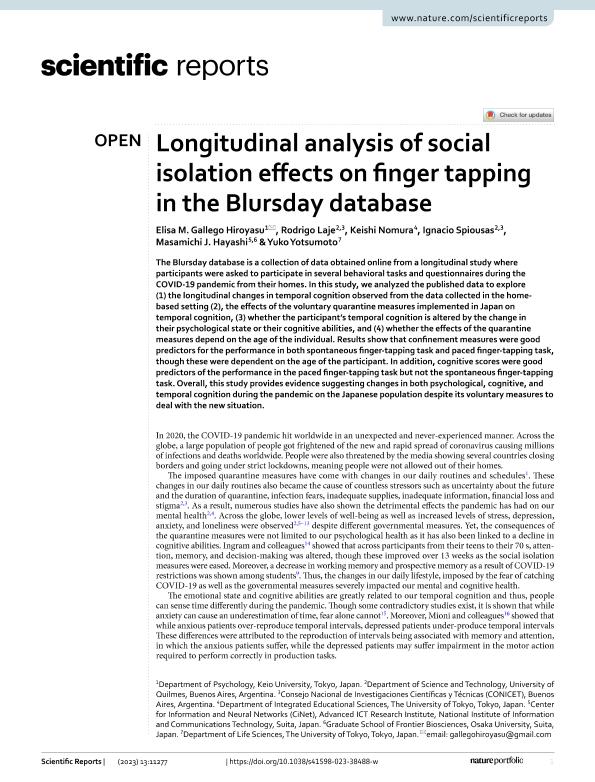Mostrar el registro sencillo del ítem
dc.contributor.author
Gallego Hiroyasu, Elisa M.
dc.contributor.author
Laje, Rodrigo

dc.contributor.author
Nomura, Keishi
dc.contributor.author
Spiousas, Ignacio

dc.contributor.author
Hayashi, Masamichi J.
dc.contributor.author
Yotsumoto, Yuko
dc.date.available
2023-12-13T14:43:45Z
dc.date.issued
2023-07
dc.identifier.citation
Gallego Hiroyasu, Elisa M.; Laje, Rodrigo; Nomura, Keishi; Spiousas, Ignacio; Hayashi, Masamichi J.; et al.; Longitudinal analysis of social isolation effects on finger tapping in the Blursday database; Springer; Scientific Reports; 13; 1; 7-2023; 1-16
dc.identifier.issn
2045-2322
dc.identifier.uri
http://hdl.handle.net/11336/220136
dc.description.abstract
The Blursday database is a collection of data obtained online from a longitudinal study where participants were asked to participate in several behavioral tasks and questionnaires during the COVID-19 pandemic from their homes. In this study, we analyzed the published data to explore (1) the longitudinal changes in temporal cognition observed from the data collected in the home-based setting (2), the effects of the voluntary quarantine measures implemented in Japan on temporal cognition, (3) whether the participant’s temporal cognition is altered by the change in their psychological state or their cognitive abilities, and (4) whether the effects of the quarantine measures depend on the age of the individual. Results show that confinement measures were good predictors for the performance in both spontaneous finger-tapping task and paced finger-tapping task, though these were dependent on the age of the participant. In addition, cognitive scores were good predictors of the performance in the paced finger-tapping task but not the spontaneous finger-tapping task. Overall, this study provides evidence suggesting changes in both psychological, cognitive, and temporal cognition during the pandemic on the Japanese population despite its voluntary measures to deal with the new situation.
dc.format
application/pdf
dc.language.iso
eng
dc.publisher
Springer

dc.rights
info:eu-repo/semantics/openAccess
dc.rights.uri
https://creativecommons.org/licenses/by/2.5/ar/
dc.subject
COGNITIVE SCIENCE
dc.subject
TIME PROCESSING
dc.subject
FINGER TAPPING
dc.subject
SOCIAL ISOLATION
dc.subject.classification
Otras Ciencias Biológicas

dc.subject.classification
Ciencias Biológicas

dc.subject.classification
CIENCIAS NATURALES Y EXACTAS

dc.title
Longitudinal analysis of social isolation effects on finger tapping in the Blursday database
dc.type
info:eu-repo/semantics/article
dc.type
info:ar-repo/semantics/artículo
dc.type
info:eu-repo/semantics/publishedVersion
dc.date.updated
2023-12-12T13:08:56Z
dc.journal.volume
13
dc.journal.number
1
dc.journal.pagination
1-16
dc.journal.pais
Reino Unido

dc.journal.ciudad
Londres
dc.description.fil
Fil: Gallego Hiroyasu, Elisa M.. Keio University; Japón
dc.description.fil
Fil: Laje, Rodrigo. Consejo Nacional de Investigaciones Científicas y Técnicas; Argentina. Universidad Nacional de Quilmes. Departamento de Ciencia y Tecnología; Argentina
dc.description.fil
Fil: Nomura, Keishi. The University of Tokyo; Japón
dc.description.fil
Fil: Spiousas, Ignacio. Universidad Nacional de Quilmes. Departamento de Ciencia y Tecnología; Argentina. Consejo Nacional de Investigaciones Científicas y Técnicas; Argentina
dc.description.fil
Fil: Hayashi, Masamichi J.. No especifíca;
dc.description.fil
Fil: Yotsumoto, Yuko. The University of Tokyo; Japón
dc.journal.title
Scientific Reports
dc.relation.alternativeid
info:eu-repo/semantics/altIdentifier/url/https://www.nature.com/articles/s41598-023-38488-w
dc.relation.alternativeid
info:eu-repo/semantics/altIdentifier/doi/http://dx.doi.org/10.1038/s41598-023-38488-w
Archivos asociados
